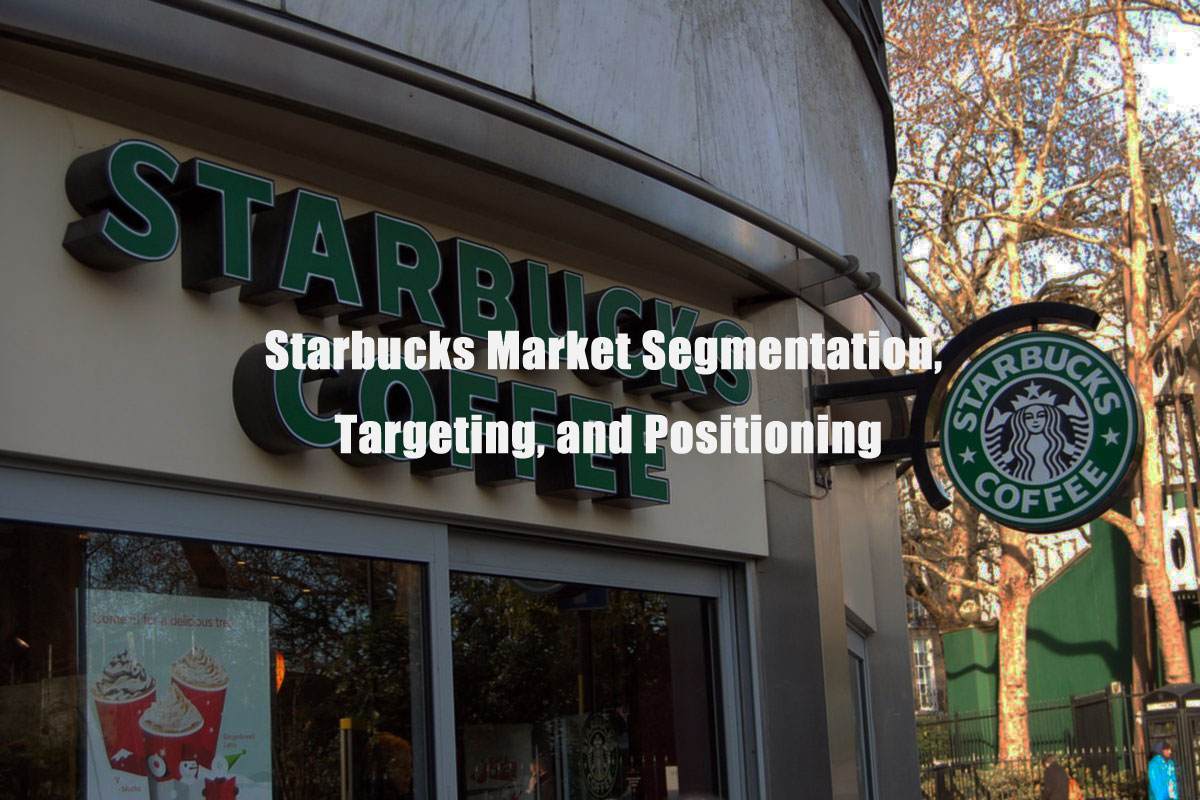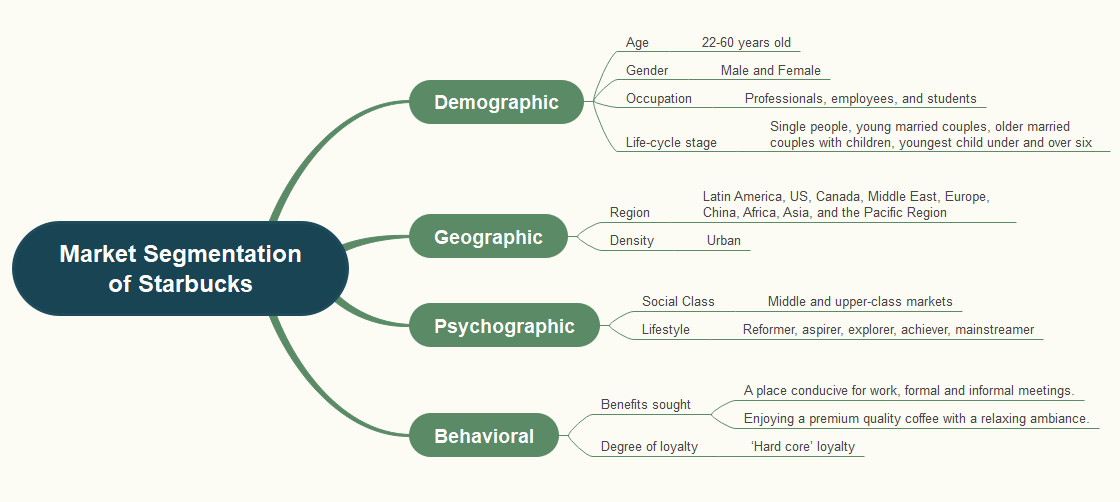Starbucks targets affluent, urban professionals and millennials who value premium coffee experiences and social status. They seek convenience, quality, and a trendy ambiance.
Starbucks has carved out a niche among urban professionals and millennials. These individuals appreciate premium coffee, value social experiences, and often seek a place to unwind or work. The company focuses on providing a unique, high-quality experience that matches the lifestyle of its target audience.
Starbucks outlets offer a cozy, inviting atmosphere where customers can relax or be productive. With free Wi-Fi, comfortable seating, and a range of menu options, Starbucks caters to those who prioritize both convenience and quality. This strategy has helped Starbucks maintain a loyal customer base and a strong brand identity.
The Essence Of Starbucks’ Appeal
Starbucks attracts a diverse, experience-seeking audience with a love for premium coffee and a cozy atmosphere. Their target market values quality, social engagement, and a sense of community, making Starbucks a lifestyle choice.
Crafting An Exclusive Image
Starbucks creates a feeling of luxury and exclusivity. They use high-quality ingredients and unique flavors. Their stores have a cozy and welcoming atmosphere. This attracts people who love to relax and enjoy their coffee time. The brand also appeals to those who value sustainability and ethical sourcing.
Beyond Coffee: A Lifestyle Choice
Starbucks is more than just a coffee shop. It represents a lifestyle choice. People visit Starbucks to meet friends, work, or study. The brand promotes a sense of community. Their loyalty programs and customizable drinks make customers feel special. This helps build a strong connection with the brand.
Decoding The Elite Sipper
Starbucks customers value quality over quantity. They seek experiences that reflect their sophisticated tastes. These individuals aspire to lead a lifestyle that is both modern and eco-friendly. They often choose brands that align with their ethical values. These customers are not just buying coffee; they are investing in brand identity.
For many, Starbucks is a status symbol. Holding a Starbucks cup can boost one’s social image. It communicates a sense of belonging to a prestigious group. The brand helps people express their personal identity. This makes them feel unique and valued. Starbucks is more than coffee; it’s a part of their daily routine and self-expression.
Tailoring The Experience
Starbucks excels at tailoring experiences to meet their target market’s lifestyle and preferences. By focusing on quality, personalization, and community engagement, they create a unique and inviting atmosphere.
Personalization At Its Core
Starbucks focuses on personalization. Each drink can be customized. Customers can choose their favorite flavors. Options include different milk types, syrups, and toppings. This creates a unique experience for each person. People feel special and valued. They return for the personalized experience. This builds brand loyalty.
Creating Community Spaces
Starbucks creates spaces for community gatherings. Stores are designed to be cozy and inviting. Many people use Starbucks as a meeting spot. It’s a place to work, study, or relax. This sense of community keeps customers coming back. They feel like they belong. Community involvement is key to Starbucks’ success. The atmosphere encourages people to stay longer. More time in the store often leads to more purchases.

Credit: www.start.io
Marketing Strategies That Resonate
Starbucks uses social media to connect with customers. They post engaging content on platforms like Instagram and Twitter. This includes photos of new drinks and behind-the-scenes videos. They also use hashtags to get more visibility. Customers love to share their own Starbucks experiences. This creates a sense of community and belonging.
Starbucks offers a loyalty program called Starbucks Rewards. Members get points for each purchase. These points can be redeemed for free drinks and food. Members also get exclusive offers and early access to new products. The program makes customers feel valued and special. It encourages them to visit more often.
Challenges And Adaptations
Consumer tastes change quickly. Starbucks must adapt to these changes. People now prefer healthier options. So, Starbucks offers more salads and juices. Seasonal drinks also attract customers. Starbucks creates new flavors often.
Many customers care about the environment. Starbucks focuses on sustainability. They use eco-friendly packaging. They also source coffee responsibly. Starbucks supports farmers and their communities. This builds strong customer loyalty.

Credit: www.edrawmind.com
The Future Of Elite Sipping
Starbucks is always looking to innovate. They create new drinks and food items. These innovations attract elite customers. People love trying new things. Bold flavors and unique ingredients are key. Seasonal offerings also keep the menu fresh. Customers enjoy the variety. They feel special with each visit.
The Starbucks experience goes beyond coffee. They offer a comfortable place to relax. Many stores have cozy seating and free Wi-Fi. These features make it a favorite spot for many. Special events and promotions add to the excitement. Loyalty programs reward frequent visitors. This makes customers feel valued.

Credit: www.edrawmind.com
Frequently Asked Questions
What Is Starbucks Target Audience Psychographics?
Starbucks targets urban professionals, students, and millennials. They value convenience, social experiences, and high-quality coffee. These customers are tech-savvy, environmentally conscious, and appreciate premium products.
Who Is Starbucks’ Main Target Market?
Starbucks’ main target market includes urban professionals, college students, and young adults aged 18-40, who seek premium coffee experiences.
What Is Psychographic Target Market?
A psychographic target market groups consumers by their lifestyle, interests, values, and personality traits. This helps in personalized marketing.
What Is The Behavioral Segmentation Of Starbucks?
Starbucks uses behavioral segmentation to target customers based on purchasing habits, loyalty, and frequency of visits. They offer rewards programs, personalized offers, and seasonal promotions to engage and retain customers effectively. This approach helps them cater to different customer needs and preferences.
What Is Starbucks’ Target Market?
Starbucks’ target market includes young professionals, students, and urban dwellers who value quality coffee and a relaxing atmosphere.
Conclusion
Starbucks’ target market is defined by a blend of lifestyle choices and personal values. Understanding their psychographic profile helps tailor marketing strategies effectively. This approach ensures brand loyalty and customer satisfaction. Analyzing these factors can lead to more personalized and successful marketing efforts for Starbucks.
